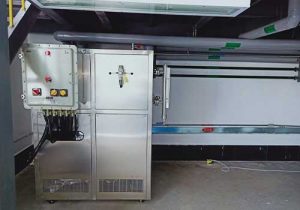What are the common faults and causes of the chiller cooling system?
What are the common faults and causes of the chiller cooling system?
The most common faults in the cooling system are high water temperature, hole leakage or damage to the cylinder water jacket, insufficient cooling water, excessive scale in the radiator, and reduced heat dissipation performance, which require timely treatment.
Lack of liquid in the cooling system can cause hole leakage or damage to the cylinder water jacket, leading to the outflow of cooling water. The solution is to stop the leakage of the leaked liquid. If severe, replace the radiator; Replace the inlet and outlet water pipes; Replace the switch.
The high temperature of the engine coolant is caused by insufficient cooling water. The solution is to add cooling water in a timely manner. If the radiator leaks, repair it; Adjust the tightness of the fan drive belt or replace it with a new belt; Clean the cooling system and remove scale; Repair or replace the water pump; Check the water outlet pipe.
1. Evaporation pressure too low:
Reason: (1) Insufficient cold water volume. (2) Low cooling load. (3) The throttle orifice plate is faulty (only causing low evaporation pressure). (4) The heat transfer tube of the evaporator deteriorates heat transfer due to pollution such as scale (only causing the evaporation pressure to be too low). (5) Insufficient refrigerant volume (only causing low evaporation pressure).
Solution: (1) Check the cold water circuit to ensure that the cold water volume reaches the rated water volume. (2) Check the set temperature of the automatic start stop device. (3) Check if the expansion throttle pipe is unobstructed. (4) Clean the heat transfer tube. (5) Replenish the refrigerant to the required amount.
2. Excessive condensation pressure:
Reason: (1) Insufficient cold water capacity of the chiller. (2) The capacity of the cooling tower has decreased. (3) The cold water temperature is too high and the cooling capacity is too large, which increases the load on the condenser. (4) There is air present. (5) The condenser tube has deteriorated heat transfer due to fouling such as scale.
Treatment method: (1) Check the cooling water circuit and adjust it to the rated flow rate. (2) Check the cooling tower. (3) Check the expansion throttle pipe, etc., to ensure that the cold water temperature approaches the rated temperature as soon as possible. (4) Perform air extraction operation to remove air. If the air extraction device needs to operate frequently, it is necessary to identify the area where air leakage occurs and eliminate it. (5) Clean the pipes.
3. Low oil pressure difference:
Reason: (1) The oil filter is blocked. (2) Excessive opening of the oil pressure regulating valve (oil drain valve). (3) The output of the oil pump decreases. (4) Bearing wear. (5) The oil pressure gauge (or sensor) is malfunctioning. (6) Excessive refrigerant mixed in the lubricating oil (due to oil foaming during start-up, resulting in low oil pressure).
Treatment method: (1) Replace the oil filter element. (2) Turn down the oil pressure regulating valve to increase the oil pressure to the rated oil pressure. (3) Disassembly inspection. (4) Replace the bearings after disassembly. (5) Check the oil pressure gauge, recalibrate the pressure sensor, and replace it if necessary. (6) After the refrigeration machine is stopped, it is necessary to put the oil heater into operation and maintain the given oil temperature (confirm whether the oil heater is disconnected and whether the temperature control setting of the oil heater is correct).
Related recommendations
Causes of Hydraulic Shock Failure of Low Temperature Chiller Compressor
1302Causes of Hydraulic Shock Failure of Low Temperature Chiller Compressor As a classification of industrial chillers, low-temperature chillers are widely used in industrial applications. During...
View detailsprocess heating equipment
343Introduction to Process Heating EquipmentProcess heating equipment encompasses a wide range of machinery and systems designed to raise the temperature of materials during industrial processes. Wh...
View details100 ton water cooled chiller
256IntroductionIn the world of high - capacity cooling systems, the 100 - ton water cooled chiller stands out as a crucial piece of equipment. With a cooling capacity equivalent to removing 1,200,00...
View detailsIs it better to increase or decrease the flow rate of the water pump for a 20 ton chiller?
1108Is it better to increase or decrease the flow rate of the water pump for a 20 ton chiller? Excessive or insufficient flow rate of the water pump in an industrial chiller can have a cert...
View details
 LNEYA Chiller
LNEYA Chiller






HelloPlease log in